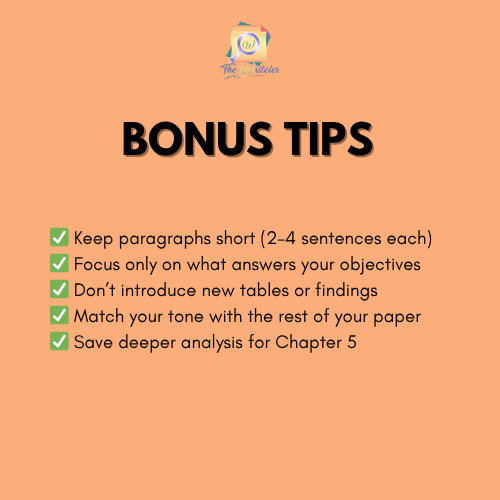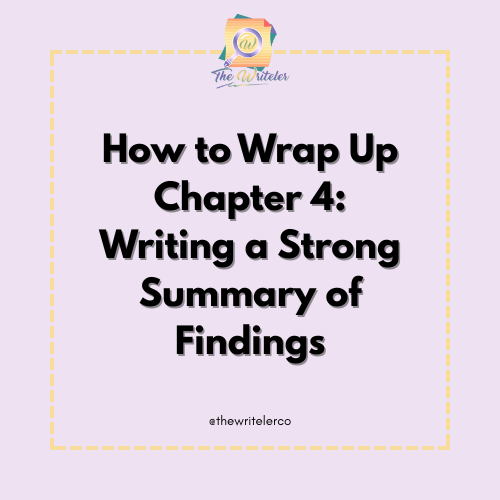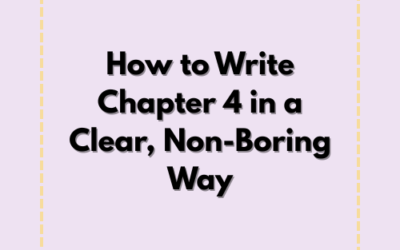After presenting tables, graphs, and key insights in Chapter 4, it’s time to write one of the most important parts—your summary of findings. But here’s the catch: many students either overdo it with repetition or barely explain what the results mean.
Luckily, crafting a strong and clear summary of findings doesn’t have to be complicated. In this blog, we’ll walk you through how to write a summary that is concise, insightful, and sets up Chapter 5 perfectly.
Why the Summary of Findings Matters
Before jumping into writing, let’s understand why the summary of findings is important.
The summary of findings serves as the closing section of Chapter 4. It provides a clear snapshot of your most important results and answers your research questions in plain language. While the rest of the chapter dives deep into data, this section pulls everything together in one place.
It also helps readers transition smoothly into your discussion or interpretation in Chapter 5—so yes, this part truly matters.
When to Write the Summary of Findings
Although this section comes at the end of Chapter 4, you don’t have to wait until the very end of your writing process. In fact, it can help to:
- Review your research questions or hypotheses
- Skim through all your tables and charts
- Highlight only what directly answers your objectives
That way, your summary of findings becomes focused—not a repeat of everything you’ve already said.
How to Write a Strong Summary of Findings
Writing this part doesn’t require fancy words or deep analysis. Instead, aim for clarity and directness. Here’s a simple step-by-step method:
1. Restate Your Research Questions or Objectives
Begin by reminding the reader what you set out to answer.
Example:
“This study aimed to examine the relationship between sleep quality and academic performance among senior high school students.”
2. Highlight Key Findings Aligned With Those Questions
Then, summarize the most relevant results that provide an answer.
Example:
“The results showed that students with higher sleep quality scores had significantly better GPAs (p < 0.01).”
3. Avoid Too Many Numbers or Raw Data
Instead of throwing in means and percentages again, explain what the results mean in plain words.
Bad:
“The mean GPA for Group A was 89.45 and Group B was 82.65, with a t-value of 3.41.”
Better:
“Group A outperformed Group B significantly, confirming the link between better sleep and higher academic achievement.”
4. Use Bullet Points if Needed for Clarity
If you have multiple findings, using bullet points can improve flow and reader comprehension.
What to Avoid in Your Summary of Findings
Even though the goal is simplicity, many writers fall into common traps. Here’s what not to do:
- ❌ Repeating entire paragraphs from earlier in Chapter 4
- ❌ Including findings that weren’t discussed earlier
- ❌ Adding your personal opinions or interpretations (save that for Chapter 5)
- ❌ Overloading the section with statistics instead of conclusions
Instead, focus on being concise, logical, and tied directly to your research aims.
Use Transitions to Strengthen Your Summary of Findings
To keep your summary of findings smooth and professional, add transitions like:
- “In summary…”
- “These findings suggest that…”
- “Overall, the results indicate…”
- “As outlined above…”
- “Each objective has been addressed as follows…”
Transitions help your thoughts flow naturally, making the summary easier to follow.
✍️ Need Help Writing Your Summary of Findings?
The Writeler Co. is here to support students and professionals who are juggling research with work, life, and business. Whether you’re writing a thesis, capstone, or dissertation for your master’s or Ph.D., we help you efficiently navigate the research journey — from brainstorming to proofreading.
📩 Message us today to get started.
📚 Let’s turn your research idea into a powerful paper.
Extra Tips for a Powerful Summary of Findings

Conclusion
Wrapping up Chapter 4 with a solid summary of findings is more than just an academic requirement—it’s your chance to clearly show what your research has uncovered. By focusing on the main points, avoiding overload, and staying aligned with your research questions, you’ll end the chapter on a strong note.
Most importantly, don’t overthink it. Say what you found, explain what it means, and keep it moving.
And remember, if you want it polished and powerful—The Writeler Co. is just a message away.





0 Comments